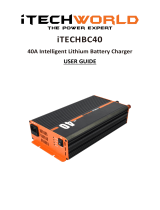
3. DANGER ELECTRICAL SHOCK HAZARD: Operating the inverter
without proper grounding may result in death or serious injury.
Please ensure that proper ground connections are made during
installation. Please consult a licensed electrician if you are
unsure.
4. DANGER ELECTRICAL SHOCK HAZARD: Before attempting to
clean the inverter disconnect DC power and any circuits
connected to the inverter.
5. DANGER ELECTRICAL SHOCK HAZARD Keep away from children:
The inverter produces 240VAC, treat the AC output receptacles
the same as regular wall AC sockets at home.
6. DANGER: Do not under any circumstances connect the output
terminals of the inverter to an incoming AC source, this will
result in permanent damage to the inverter and void all
warranties.
7. DANGER EXPLOSION HAZARD: Do not use the inverter in an
environment where flammable fumes or gases are present
(such as gas bottles, petrol engines or lead acid battery
compartments)
8. Warning: Do not use substandard or damaged wiring with this
inverter, it may cause fire or a shock hazard.
9. Warning: When connecting the DC input, pay close attention to
the polarity of the input. As a reverse polarity connection will
cause permanent damage to the inverter and void all warranty.
10. Warning: When using inductive loads, please note that they can
draw up to 10 times its rated power draw. Furthermore, when
running appliances with a locked rotor current such as pumps,
or compressors, please turn of other non-essential appliances
that are connected to the inverter.
11. Warning: Please ensure all ventilation vents and fan vents are
not obstructed in any way. Please keep a minimum of 60mm
distance around the sides of the inverter to ensure adequate
ventilation. Failure to do so may result in fire or failure of the
inverter.
12. Warning: Avoid dropping any metal tools or objects on the
battery. Doing so could create a large spark or short circuit
which may cause an explosion.

























